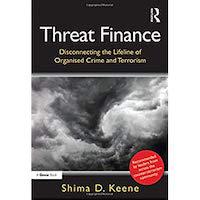
Matt Zbrog
Before the September 11 attacks, al-Qaeda transferred more than a quarter-million dollars through various pathways of the formal banking sector to fund the 19 hijackers. The hijackers all had U.S. bank accounts attached to their real identities and accessed their illicit funds through ATMs and debit cards.
Because they were mostly relatively small in size, most of the transactions did not set off red flags and would not even by today’s standards. While the majority of scholars and policymakers focus on the sources or outcomes of terrorism, a small group of forensic professionals has been focusing on a critical intermediary step: following the money.
Threat financing is the most violent form of financial crime. The U.S. State Department defines threat financing as the funding of groups or individuals who pose a threat to domestic, international, and regional security. The term is still new and one with nuanced and evolving applications.
“The U.S. government considers threat financing broadly to include the movement of funds by not just terrorist organizations and militant extremists, but also violent organized crime syndicates and rogue states that are trying to disguise their funding activities,” says Dr. Moyara Ruehsen, a professor at Middlebury Institute of International Studies, who has worked with the U.S. government on threat finance and written extensively on the subject.
“In practice, the term ‘threat financing’ is usually used to refer to terrorist financing and weapons of mass destruction (WMD) proliferation financing by both nation-states and non-state actors. This can include everything from a shipping agent sending funds to pay for port fees for a North Korean vessel evading international sanctions, to someone sending money to pay for the airfare for a young foreign fighter headed to Syria or Yemen.”
While threat financing is similar to traditional money laundering as it relates to masking the source, purpose, and destination of funds, it differs from money laundering in that: its goal is not necessarily monetary profit; the associated crime may not have been committed yet. In threat financing, money is moved through cash couriers, informal networks (e.g., Halawa systems and money service businesses), high-value commodities, false-trade invoicing, and the traditional banking sector.
When selecting one of these methods of moving money, illicit organizations such as al-Qaeda typically take into consideration a mix of factors such as risk, convenience, volume, simplicity, cost, and speed. It is up to forensic professionals to discern those methods and motives.
For forensic professionals combating threat financing, the primary goal is to intercept, disrupt, and apprehend those who would fund malevolent actors, thus preventing acts of terror. But even when suspicious transactions are discovered after the fact, there’s plenty to be gained from successful detection of threat finance.
“Even in cases where this strategy cannot prevent a criminal act from occurring, following financial footprints around the globe might be the only way to find out who is truly behind the criminal act and hold them accountable,” says Dr. Ruehsen. “It’s also the only way to seize, freeze and forfeit assets belonging to terrorists, WMD proliferators, and other criminal organizations.”
One famous case of threat financing occurred not through a web of convoluted money transfers and dark web technology, but through jars of honey. In the wake of the September 11th attacks, FBI agents acted on a tip that a Yemeni sheik, Mohammed Ali Hassan Al-Moayad, was raising money in Brooklyn to supply to al-Qaeda. Rumored to have supplied the terrorist organization with more than $20 million, investigators focused their energy on finding the sheik’s money trail.
With the help of an informant, investigators learned that many of the donations Al-Moayad received were in cash, and they knew that his cash deposits would leave a trail. What investigators also discovered, however, was that the cash was not being deposited at all, but instead physically shipped.
Cash is heavy. One million dollars in $20 bills weighs more than 100 pounds and stacks almost 18 feet high. Transporting $20 million in cash would require shipping it cargo-style. Combining this knowledge with a curious tip about Yemeni honey, federal agents arrested two suspects at JFK International, and, in doing so, found cardboard boxes filled with honey jars—along with $140,000 cash—all destined for Yemen.
In the ensuing investigation, informally codenamed Black Bear, Al-Moayad was convicted of providing material support to both al-Qaeda and Hamas, fined $1.25 million, and sentenced to 75 years in prison—a sentence which was overturned on appeal in 2008 due to missteps by the prosecution during the initial trial.
Interestingly enough, the honey story turned out to be bigger than a single Yemeni sheik. After the first shipments were found, investigators dug into the honey trade between the U.S. and Yemen. The data showed that Yemen imported more than 600 metric tons of honey per year, and exported its own special brand of honey derived from the Sidr tree, native to the Levant. The transactions were suspicious and suggested impropriety.
In some cases, it revealed that cash did not even need to be physically shipped at all; instead, the price of the honey would simply be inflated and the proceeds funneled to or from nefarious ends. As a result, several seemingly innocuous honey suppliers in Yemen have been designated terrorism-related entities by the Office of Foreign Asset Control.
Today’s forensics professionals combat threat financing on a number of axes. Trade Transparency Units (TTUs) sift through big data and search for unusually priced transactions.
Red flags such as maxed out credit cards and closed banking accounts can indicate a possible extremist traveler about to leave for a conflict zone. Geographic indicators are also becoming increasingly useful in identifying threat-based transactions, and emerging areas of focus involve blockchain forensics and cybersecurity. In all cases, combating threat financing requires a sophisticated understanding of both the global financial system and geopolitical, geographical, and cultural factors.
“Curiosity and good instincts are the most important skills,” says Dr. Ruehsen. “It is also important to be able to recognize whether something is out of the ordinary and be motivated to dig further to find out more information. Of course, sometimes you won’t have time to dig deeper, and that is where strong general knowledge about the world—international geography, economics, business, culture—comes into play.”
Due to the time-sensitive nature of threat financing, and combined with the vast amounts of harmless financial transactions that occur every day, forensics professionals rely on an educated sense of instinct to fish out possible transactions. Knowledge of foreign shipping ports can help investigators recognize whether a shipping route is unnecessarily convoluted. A large shipment of advanced technology exported from a country with little manufacturing base or a shipment of wine from Saudi Arabia will jump out instantly to an investigator working to counter threat finance.
“These character traits—curiosity, good instincts and an interest in staying informed about the world—are extremely important for any investigator, and cannot easily be taught,” says Dr. Ruehsen. “Other skills such as data analytics, cybersecurity basics, blockchain forensics, foreign languages, risk scoring, communication skills—written and spoken—are more easily taught in the classroom.”
Those who have the curiosity and instinct can consider some of the programs below and learn how to get started in countering threat finance.
Middlebury Institute of International Studies
The financial crime management program at the Middlebury Institute of International Studies prepares students to combat threat financing at the highest echelons. Middlebury alumni of this program have gone to work in a financial crime management capacity at the Central Intelligence Agency, the Federal Bureau of Investigation, the U.S. Treasury, Google, Facebook, JPMorganChase, Deloitte, Interpol, and PayPal, to name a few.
The program can be taken as a specialization in conjunction with a degree program at the institute, such as the master’s in non-proliferation (of WMDs) and terrorism studies, or as a standalone 16-credit certificate. The core curriculum goes over money laundering, trade-based crimes, sanctions, the legal aspects of compliance, and financial crime investigation and compliance management. Students may then select electives which include courses in WMD proliferation financing, terrorism financing, and nonproliferation laws, sanctions, policy, and financing.
The dual master of arts in international relations and MBA program at BU’s Questrom School of Business equips students for the global stage of threat finance. The MBA program provides students with foundational business knowledge as well as specialized knowledge of international financial management and political, economic, and country risk. The international studies program covers core areas like theory and policy, political economy, security studies, and regional studies.
Students must be proficient in a foreign language before the completion of their degree—a skill that threat financing experts value highly. While not explicitly dedicated to threat financing, BU’s dual degree program can give graduates a global perspective of financial and accounting practices and the geopolitical motives and methods of threat financing.
Association of Certified Anti-Money Laundering Specialists
ACAMS is the largest organization dedicated to enhancing the knowledge, skills, and expertise in financial crime detection and prevention experts. A hub for educational resources, industry talks, and networking opportunities in combating financial crime, the association provides an online anti-money laundering specialist certification (CAMS), which is the industry’s gold standard.
The ACAMS has also created an online training certificate in counter-terrorist financing, aimed at helping intermediate-career professionals better protect their institutions from threat financing vulnerabilities. In the four-week class, students engage in a short lecture and two 90-minute virtual classroom sessions that go over case studies, polls, and practice questions on the ‘good and evil’ players in threat financing. A brief homework assignment and final exam round out the four-week certificate program.
ACAMS offers similar short-duration certification programs for sanctions compliance and trade-based money laundering. An introductory first year of ACAMS membership and all its associated benefits is included with registration for any course.

Dr. Keene is a director of the Conflict Studies Research Center and a senior fellow at the United Kingdom’s Institute for Statecraft, where she specializes in the economics of terrorism, insurgency, and organized crime. Outside of the UK, she works with international organizations such as the North Atlantic Treaty Organization (NATO), the Organization for Security and Co-operation in Europe (OSCE), the Council of Europe, and several U.S. government, military, and law enforcement agencies.
Dr. Keene literally wrote the book on threat financing—a culmination of her quarter century of experience in investment banking, academia, defense intelligence, and military service. She also has written several academic papers, including recent work on operationalizing counter threat finance strategies for the U.S. Army War College.
Dr. Keene holds a doctorate in international criminal law and a master’s in defense and security studies.

Mr. Dennis Lormel serves on the advisory board of the ACAMS, where he helps with training programs and seminars on threat financing. He spent 28 years as a special agent in the FBI, gaining extensive major case experience in complex and document-intensive financial investigations, and eventually becoming chief of the FBI’s financial crimes program.
In the wake of the September 11th terrorist attacks, Mr. Lormel formed the FBI’s terrorist financing operations section, a multi-agency entity that is recognized as one of the world’s most elite task forces for disrupting terrorist-related financing. He has received numerous commendations for his service, including the CIA’s award for excellence in counterterrorism and the 2010 ACAMLS Volunteer of the Year Award. Mr. Lormel now provides consulting services related to threat financing, speaks at international conferences on the subject, and writes contributions to The Counterterrorism Blog.

Dr. Moyara Ruehsen oversees the Financial Crime Management program at the Middlebury Institute of International Studies, where she teaches courses on proliferation financing, financial investigation, and trade-based financial crime. She also hosts a seminar on threat financing.
Dr. Ruehsen has been writing about threat finance since the September 11th attacks and has continued to write about the shifting dynamics of the subject in the wake of newer terrorist events. Throughout her career, she has consulted, lectured, and conducted training in Kuwait, Iran, Iraq, the United Arab Emirates, and Palestine, as well as for the U.S. government and private sector. In addition to teaching, writing, and consulting, she previously served on the editorial board of Money Laundering Alert and worked for the Middle East Task Force of the ACAMS.
A former Fulbright scholar with a master’s in Middle East studies, Dr. Ruehsen earned her doctorate in international economics from John Hopkins University before spending a postdoctoral year at the University of California, Berkeley to study international organized crime.

Matt Zbrog
Matt Zbrog is a writer and researcher from Southern California. Since 2018, he’s written extensively about the increasing digitization of investigations, the growing importance of forensic science, and emerging areas of investigative practice like open source intelligence (OSINT) and blockchain forensics. His writing and research are focused on learning from those who know the subject best, including leaders and subject matter specialists from the Association of Certified Fraud Examiners (ACFE) and the American Academy of Forensic Science (AAFS). As part of the Big Employers in Forensics series, Matt has conducted detailed interviews with forensic experts at the ATF, DEA, FBI, and NCIS.